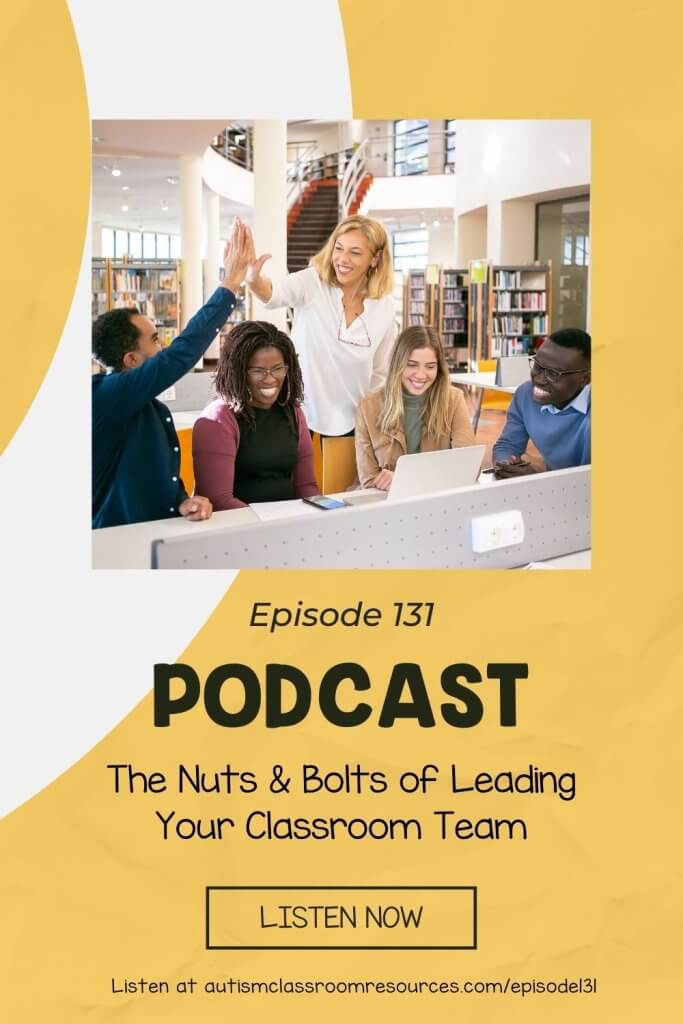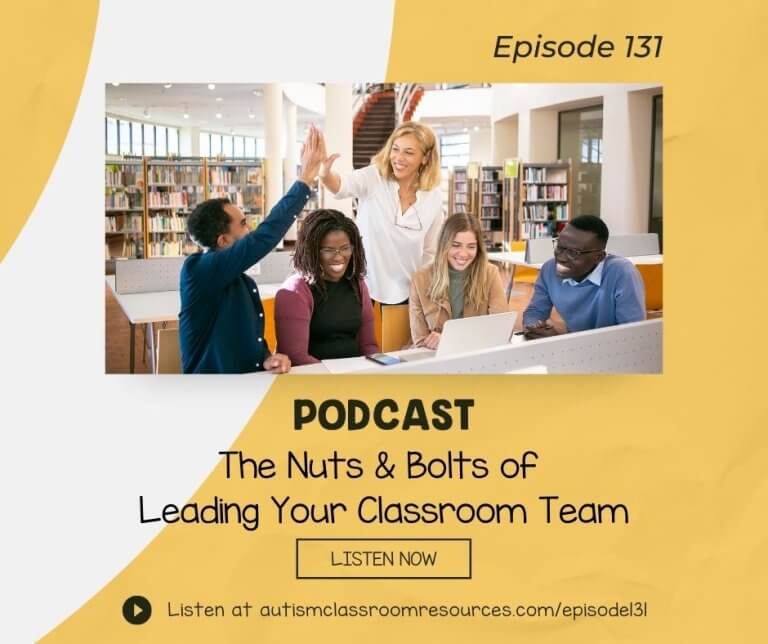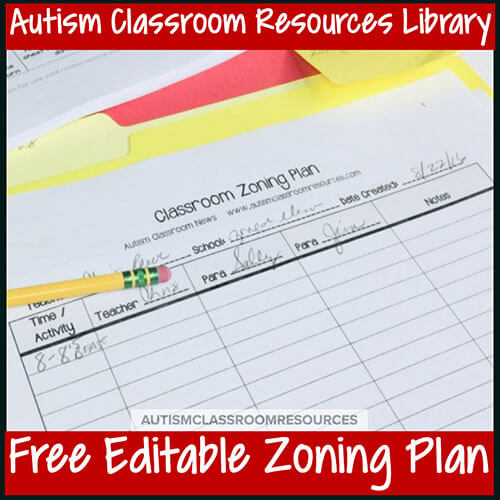Welcome to the Autism Classroom Resources Podcast, the podcast for special educators who are looking for personal and professional development.
Christine Reeve: I’m your host, Dr. Christine Reeve. For more than 20 years, I’ve worn lots of hats in special education but my real love is helping special educators like you. This podcast will give you tips and ways to implement research-based practices in a practical way in your classroom to make your job easier and more effective.
Welcome back to the Autism Classroom Resources Podcast. I am Chris Reeve. Hello. I am excited to have you here. We are talking about another part of organizing the classroom this month in August. This is one of my favorite topics because I think it’s one of the things that teachers struggle with a lot. I won’t say it’s the hardest thing because I think that’s probably data but I do think that working and building your classroom team is a very difficult thing for teachers because I don’t think that we’re necessarily taught how to do that in school.
In this month of episodes, I’m going to be talking about how to build your classroom team and how to be the classroom leader. Today, I’m going to start out with the nuts and bolts of being the classroom leader because even though I know that some of you may just be out of school, you are the leader, and even though the paraprofessionals in the classroom may have three times as much experience as you do, it’s still your job to lead the team.
Now, I do not mean that you are the boss of them and that is not the way you should be leading anyway. Even though no one ever taught you how to lead or how to be a good leader—and believe me, everyone in education has an opinion on that so we are not going to spend any time talking about the philosophy of leadership—the fact is that it’s your job to lead the classroom, but it’s okay because leadership is not some big scary deal and it’s not something that you should be the big leader about. It’s really just about building relationships with people you work with and working with them to help them work the classroom just like we build relationships with our students. Easy peasy lemon squeezy.
Seriously, we have strategies and tools that can help with it and so I’m going to spend today’s episode talking about the nuts and bolts of building the structure with the classroom staff to work as a team because just like with our students, it is all about relationships and sharing expectations.
Then we’ll talk later in the series about ways to provide training to the staff even when you have no collaboration time and how you can provide feedback effectively because we know there is no time for training and collaboration individually. Finally, I’ll finish out the month with some troubleshooting tips when all of these strategies just aren’t getting the job done.
In addition to all of this, I’ve got some downloads today that can help you set up the structure in your classroom and I’ll share those during the episode. If you really want to learn more about how to set yourself up for success this year in just 15 minutes a day, maybe three times a week, come check out the Special Educator Academy. We’ve got tons of tools and tips to help you help your students from workshops and trainings to tips and templates.
We have a whole part of a course on working with classroom teams. We’ve got a ton of quick wins and lightning tips on building your classroom team to help you work and plan efficiently. Most of them can be accessed in 10 to 15 minutes at a time, so grab your seven-day free trial at specialeducatoracademy.com. Now, let’s get started.
Just like with setting up a classroom and working with students, working with staff is all about the structure and relationships as well. Sometimes I think all of life is about structure and relationships, but maybe that’s just me. As you’re setting up the classroom, the structure includes not just the structure for students but the staff, of course, are part of that structure too.
Typically, the first part of that is the classroom zoning plan. If you have listened to the podcast for a while or if you’ve read the blog, then you’ve heard me talk about the zoning plan. But if it’s new to you, then let me just take a minute and give you a short overview.
A zoning plan is like a staff schedule, but it’s a lot more than a staff schedule. Now, if you’re a basketball fan, you’ve already surmised that the name comes from the zone defense used on the court. You can also have a man-to-man plan but the zoning plan has just come to describe the system whether you’re using a zone or a man-to-man.
For those who aren’t basketball fans, that means that whether we’re covering an area of the room, like the table area, the snack area, or a specific set of students, Tanya, Bill, and Lucy are with me no matter where they are in the room, a zoning plan is covering whatever area or students you’re responsible for and where you are supposed to be at certain times of the day.
Now, that is a staff schedule, and that’s important, but a zoning plan gives them more information. It includes what they need to do while they are there, so taking data on this student or behavior, watch this specific kid, prompt this kid, not that one, make sure this one stays in his seat, provide accommodations for this student, prompt social skills for that student.
What they need to take with them or remember, don’t forget Jeremy’s schedule, make sure DeAndre has his talker, don’t walk Andrew by the elevator on the way to lunch, please. You are in charge of the timer. It includes jobs that aren’t always student-centered but that need to get done and assigns them to a specific person such as who’s cleaning the table after snack and who’s not cleaning the table after snack because they have other jobs to do so four people aren’t cleaning the table after snack. That’s a whole story I won’t include here.
It doesn’t include information that is going to change from day to day or week to week like a lesson plan. That’s what a lesson plan is for and you don’t want to have to print zoning plan every day or every week for the staff because eventually, you do want them to remember it and not have to refer to it at every turn.
But it gives them a good bit of information about what they should be doing in the daily routine. The key to the whole thing is that it’s written down and that means that everything in your head as the teacher and the leader is there for them to see, to know what you expect and what is needed, they know what their role is.
It’s amazing how much can be clarified by a good zoning plan. I will share some links from the blog on zoning plans in the show notes so that you can see what zoning plans look like. I’ve got some examples there and I have a free zoning plan PDF in the Free Resource Library that I’ll share in the blog post for this episode.
If you’d like more information and assistance with cheat sheets, videos, editable tutorials, and more, you can grab my building classroom teams toolkit off of TPT and you’ll get a whole bunch of stuff that can help you really build your own, or just come grab the Setting Up Classrooms course in the Special Educator Academy and I’ll walk you through how to set up the zoning plan in videos with templates and more. That’s specialeducatoracademy.com.
Another part of the classroom structure is the classroom schedule that the zoning plan, of course, is based on. I might be doing this a little backwards, and the next part is the classroom lesson plan. Lesson plans are important, precisely because they also communicate what is needed and what students are supposed to be doing, and therefore, what the staff is supposed to be doing with them. They take information, again, that’s in the teacher’s head about what the lesson is and they communicate it to the staff.
But they don’t have to be a huge time suck once you set up a good template. I’ve got free templates and examples in a post on the blog and I’ll make sure that those links to the templates and the examples from the Resource Library are in the blog post that goes with this episode as well. You can find that at autismclassroomresources.com/episode131 and it’ll have all of these links in it so that you can check them out.
Next up in the classroom development for classroom teams is setting up the vision for the classroom. I actually talk about this in Episode 3 of the podcast and you can grab that at autismclassroomresources.com/episode3, and that link will be in the blog post too. The vision is something that you develop with the classroom staff. It’s important that the staff have input into it and it isn’t something that you’re just developing without them because I’m going to share the vision just doesn’t work, that’s not the way they work, it has to be collective.
But that’s not to say that you can’t draft it and share some ideas and have them contribute ideas without doing it as a full “Let’s sit down and talk about the vision” kind of meeting because frankly, we don’t get the time to do that anymore. I long for the days when we used to get time in before the kids came to school when everybody was there, we could all go out to lunch and we could have these conversations.
That just doesn’t happen anymore so you can do it with post-it notes, emails, text, and voice messages as a way to substitute for some of that time. It certainly does help if you’ve got that time to sit down and have a real conversation. That is definitely preferable, but preferably out the window from a lot of schools a while ago.
If you have that time, TAKE IT. But if you don’t have the time, then I’ve got some tips for how to manage without that time in Episode 3. I’ll send you there for those options as well and that’s another thing that I have in the Resource Library. There’s a link there for some ideas about creating the vision and some start off kinds of phrases and a template as well.
Throughout all of these steps, essentially, what you’re doing is you’re building a classroom culture, and the way that you talk to the staff and about your staff when they aren’t there as well because they will know are all part of building that culture. It’s important to recognize that there are things you don’t know about them, about their background, about their experience, just like there are things that they don’t know about you and yours.
I always remember a time that I was working with a team, doing training, that had known me for a while. By then, probably half a year, and they just had never really worked that closely with me. But they didn’t really know my background and I was young. We were doing training and we always kind of did this collective resume. We had people talk about how many years they’d worked in the field.
We were adding up our years as a group and they said, “Well, how many years have you worked with kids with autism?” and I said, “10.” They’re like, “No, Chris, like really, how many years have you worked with kids with autism?” I’m like, “10”, and they’re like, “No, seriously, I mean you just got out of school.” I’m like, “Yeah and I started doing this 10 years ago.” They just looked at me.
It was very interesting because after I said that, they looked at me very differently because until that point, they really thought I came in and took my administrative job as just like I’m fresh off the boat and I didn’t know what I was doing. It was clear that there was a lot of background information they didn’t have about me until we had that conversation. It’s really important to have those conversations, not just to share what your experience is but find out with their experience is.
You know this is particularly true if you’re working in a situation where you and your staff come from significantly different cultures and backgrounds. Setting the tone early of asking questions instead of assuming something about someone’s life is very important. I talk a lot about this in Episode 2 of the podcast. I think it’s really worth going back and listening to that if you haven’t heard it for the different elements you might want to think about getting to know about those you work with and how to integrate the different perspectives in a classroom into your culture.
Then one of the things I think you’ll know, I think one of the things I think that we have all learned in the last couple years about different people’s culture is the importance of being open to them and the importance of opening up that dialogue and not making assumptions, and recognizing that you can’t make assumptions and that you need to have that person teach you about their culture and not be ashamed that you don’t know it. I think having those conversations are hard sometimes but it’s important. You got to build that structure of that relationship to allow you to do that.
Those are the initial steps of setting up the expectations and relationships in the classroom with the staff to start to build a foundation that allows you to be the leader of the team, to be a coach. You can look at it however you want. It doesn’t have to be named leader. I’m not saying that that’s what it is, but you essentially are the person who’s building that collaborative team and that is the team that’s going to work together towards the goal of the students’ learning.
I hope that that gives you some ideas for preparing for your next classroom. I’d love to hear your ideas in our free Facebook group at specialeducatorsconnection.com. If you’re a teacher, if you’re a paraprofessional, or related service provider, hop over and make sure to answer the two questions and we’ll be sure to get you in to share your thoughts on this. I will make sure to share the zoning plan and the classroom vision links, as well as the links to other posts and the podcasts in the post for this episode. You’ll find all of that at autismclassroomresources.com/episode131.
I am really looking forward to this short series of building classroom teams. I hope you’ll come back next week when I’ll be talking about common roadblocks in staff training in the classroom, which I know is a big topic for a lot of people. If you’re looking for support and tools to help lift you up this year and get you focused, come join in the Academy. I always remember what one of our members said: “It’s good for the soul.” Have a beautiful week.








